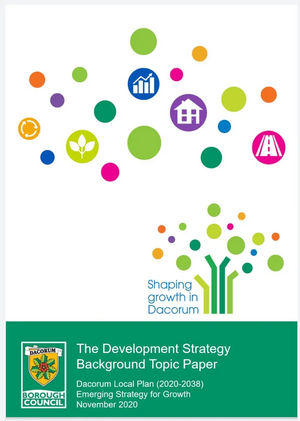Dacorum Local Plan - the Development Strategy "Topic Paper"
The Development Strategy Topic paper.

This paper is quite dense (first in a collection of 130 documents published in support of the Dacorum Local Plan), but press on - essentially this is a document which gives context and explains how the Local Plan was formulated.
Section 3 (local context and challenges) is probably the most interesting part, and Section 5 goes on to discuss why other alternatives were rejected, including lower growth levels, so is also worth a skim.
The Topic Paper starts off with an introductory section explaining the national policies and rules which have to be followed when preparing a Local Plan, in order to be reasonably certain that it is accepted by the Inspector.
Then we have a section (3) which describes policies of the Local plan, such as that for delivering the new housing growth, from maximising the use of brownfield land and urban densities, to delivering new council housing. The plan for delivering housing is all based on the figure of 922 houses per annum which has been calculated using a new algorithm (more on this https://hhlibdems.org.uk/en/article/2020/1384960/the-housing-numbers-for-dacorum-a-mutant-algorithm).
NB: This figure is 100 houses lower than that from the previous algorithm, but it should be noted that the previous algorithm was based on 2014 Office for National Statistics projections (731 per year) and the new figure is based on the 2018 ONS projections (355 houses per year). In spite of our projected housing need halving, our housing target has only reduced by 10%.
With this housing target figure, and many other considerations, such as the need for Housing to be "sustainable" (this doesn't mean what you think it does), and the Climate Emergency (which pushes housing naturally to locations where car travel is less dominant, i.e. near train stations) the Local Plan suggests a figure for housing in each of Dacorum's locations as follows:
- Hemel Hempstead 10,688
- Berkhamsted 2,236
- Tring 2,731
- Bovingdon 241
- Kings Langley 274
- Markyate 215
- Selected Small Villages, other small villages and the countryside - 514
As you can see, the vast majority of housing is focussed in Hemel (although as far as % increase in size goes, Hemel gets off lightly compared to Tring). This distribution of housing is in part a result of the geographical challenges in Dacorum which are discussed in section 3f.
- Chiltern Beechwoods
- Special Areas of Conservation
- Area of Outstanding Natural Beauty
- Sites of Special Scientific Interest
- Regionally Important Geological Sites
- Local Nature Reserves
- Local Wildlife Sites
- Green Belt
- Flood Risk areas
Each of these constraints limits the options for housing, you will have no doubt noticed already, however, that some Green Belt is allocated for housing in this Local Plan. With such a large housing target figure, this is no surprise. Why don't we try for a lower target? Well, we aren't happy about the figure either, but Section 5 goes on to discuss (convincingly? That's a matter of opinion) why other alternatives were rejected, including lower growth levels.
There are other Topic Papers - some more niche than others - please bear with us and we will try to de-mystify the ones where the titles are not self-explanatory!
If you want more, try this collection of all the Dacorum Local Plan posts.
Cllr Liz Uttley and Cllr Adrian England
